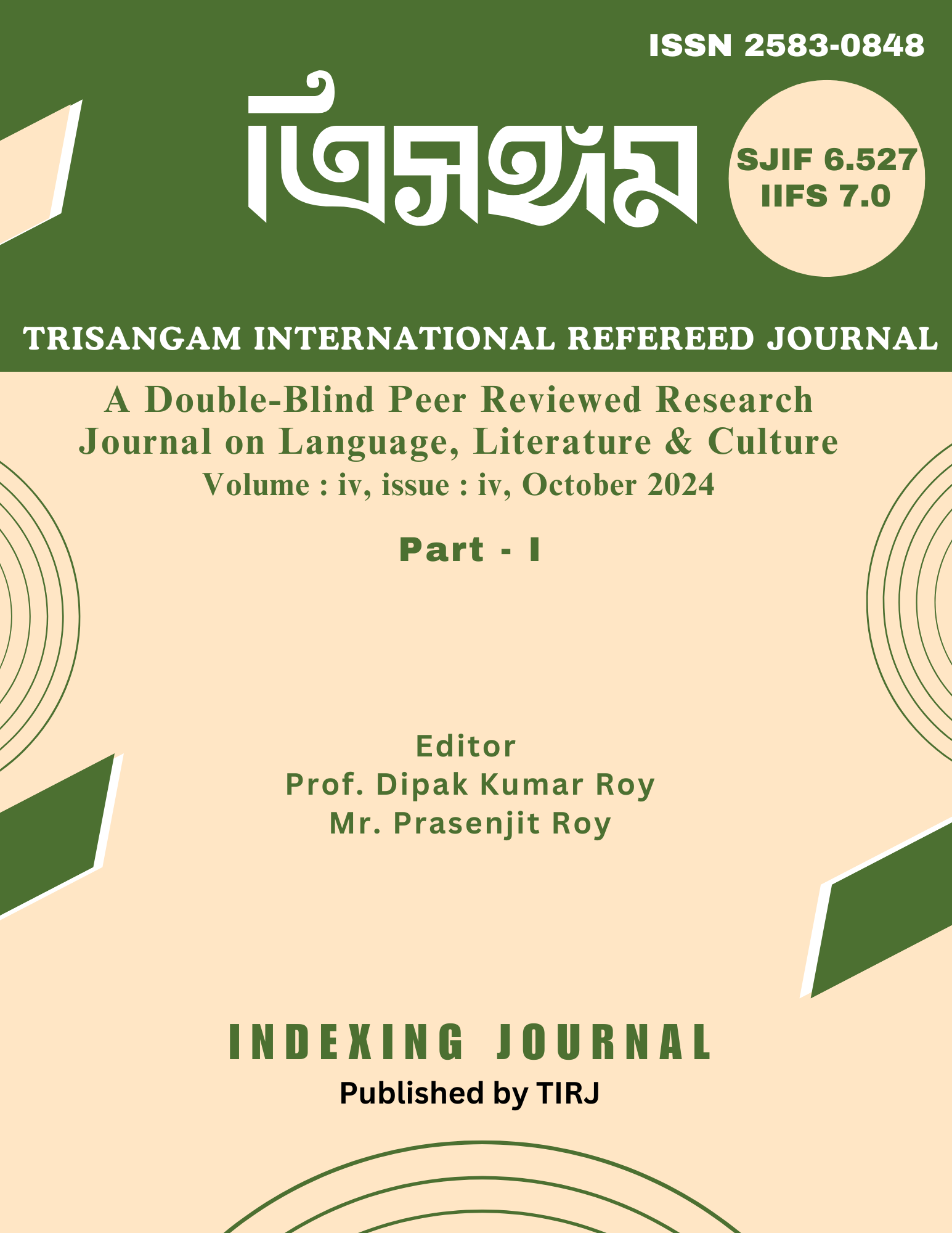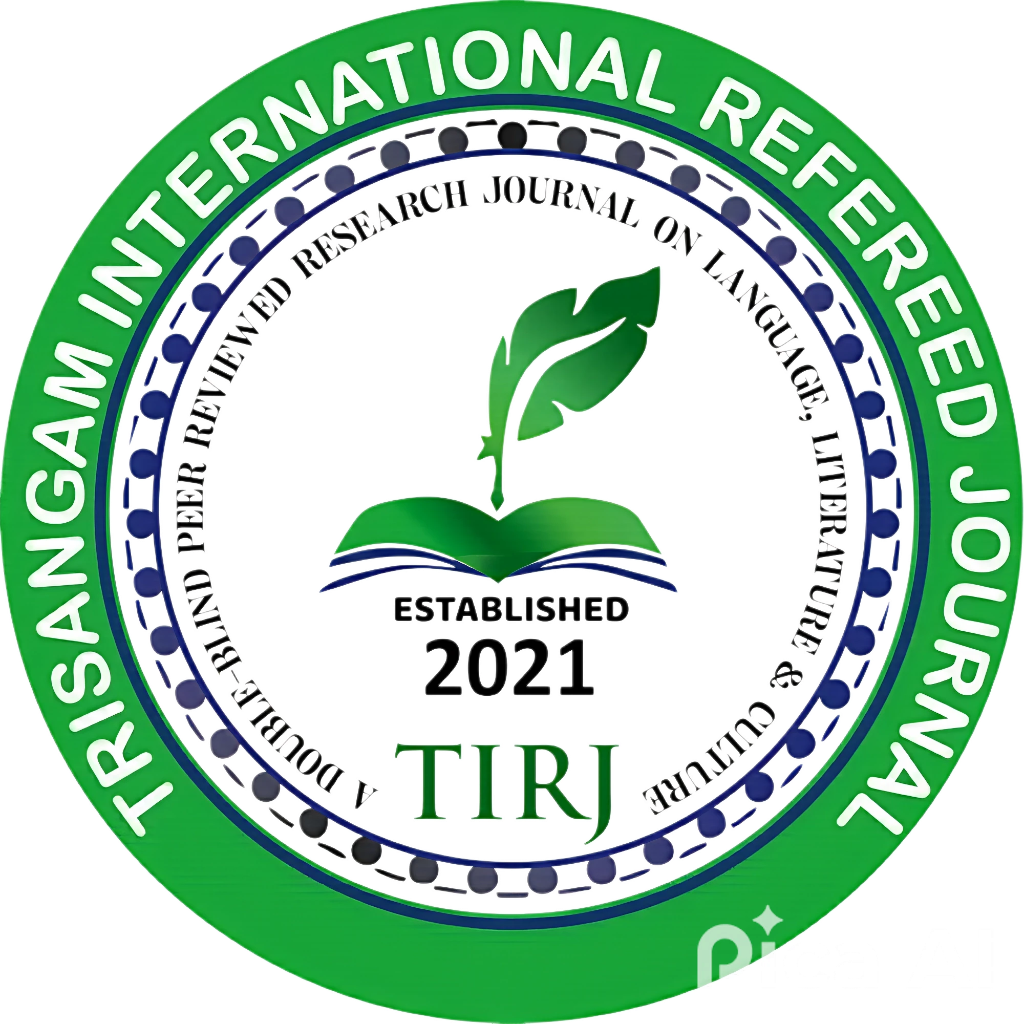Hara-Gouri’s Relationship in the Podaboli of Ramprasad and Kamalakanta : From Tantric Theory to Inside of Bengali Family/ রামপ্রসাদ ও কমলাকান্তের পদাবলীতে হর-গৌরী সম্পর্কের রূপায়ণ : তন্ত্রতত্ত্ব থেকে বাঙালির অন্দরমহল
Keywords:
- Ramprasad Sen,
- Kamalakanta Bhattacharya,
- Shakta Padaboli,
- Shiva,
- Uma,
- Tantra,
- Bhakter Akuti,
- Agomoni,
- Bijaya
Abstract
Shakta Podaboli is a very important genre in the Medieval Bengali Literature. In the crucial time of 18th century Bengali poets started to write these poems where they tried to get a mental peace and shelter to ‘Maa Kali’ for expressing their grievances and grief. Ramprasad Sen and Kamalakanta Bhattacharya are the most prominent poets in this genre. Ramprasad is a true devotee of Kali. So He manifests His veneration in the Parjay of ‘Bhakter Akuti’. In these poems He allegorically expresses the true meaning of Tantric ‘Shiva-Shakti’ theory. He reveals Tantric ‘Shatchakrabhed’ and ‘Kundalini’ theory through the metaphors of so called ‘Shiva-Gouri’s conjugal life. In this article we tried to decode that Metaphors through some tantric texts and references. Another poet Kamalakanta Bhattacharya is excellent in the Parjay of ‘Agomoni’ and ‘Bijaya’. ‘Agomoni’ and ‘Bijaya’ is basically based on Uma’s arrival in his father Himalaya’s home and departure to Kailasa. In this context, Shiva has been portrayed as a poor, old and bohemian husband of Bengali girls of that period. Uma’s mother Menaka’s anguish and tormentation is revealed here thinking of Uma’s miserable married life. Menaka sends Himalaya forcefully to Kailasa to fetch Uma only for four days and after four days when Shiva comes to take Uma mother Menaka’s heart fills with distress and disappointments. Kamalakanta’s poems reveal a common photography of contemporary Bengali Family through the cruel system of child marriage of many Uma. We tried to denote that problem through the married life of Shiva and Uma. Mother Menaka’s cry and anguishes echoes through the poems and shows us the painful married life of sacrificed one common Bengali girl whose name is Uma. She is assimilated here with mythological Shiva’s wife Uma. We analysed about it in the article.
Downloads
References
১. রায়, অমরেন্দ্রনাথ (সম্পাদিত), ‘শাক্ত পদাবলী’ (চয়ন), নবম সংস্করণ, কলকাতা বিশ্ববিদ্যালয়, ১৯৬০,
পৃ. ১২৪
২. সেন, কল্পনা, ‘রামপ্রসাদ সেন ও সমকালীন ভারতবর্ষ’, প্রথম প্রকাশ, কলকাতা, সুচেতনা, রথযাত্রা, আষাঢ়,
১৪১৮, পৃ. ১২২
৩. তদেব, পৃ. ১২৩
৪. ভট্টাচার্য, শিবপ্রসাদ, ‘ভারতচন্দ্র ও রামপ্রসাদ’, কলকাতা, মডার্ণ বুক এজেন্সি, পৃ. ৩৯৮
৫. প্রজ্ঞানানন্দ, স্বামী, ‘তন্ত্রে তত্ত্ব ও সাধনা’, চতুর্থ সংস্করণ, কলকাতা, শ্রী রামকৃষ্ণ বেদান্ত মঠ, এপ্রিল, ২০১০,
পৃ. ৭৫
৬. রায়, অমরেন্দ্রনাথ (সম্পাদিত), ‘শাক্ত পদাবলী’ (চয়ন), প্রাগুক্ত, পৃ. ১৩৩
৭. জগদীশ্বরানন্দ স্বামী অনূদিত, ‘শ্রীশ্রীচণ্ডী’, প্রথম প্রকাশ, কলকাতা, উদ্বোধন কার্যালয়, রথযাত্রা, ১৮ আষাঢ়,
১৪১৮, পৃ. ২৭১
৮. ভট্টাচার্য, শিবপ্রসাদ, ‘ভারতচন্দ্র ও রামপ্রসাদ’, প্রাগুক্ত, পৃ. ৩৯৮
৯. রায়, অমরেন্দ্রনাথ (সম্পাদিত), ‘শাক্ত পদাবলী’ (চয়ন), প্রাগুক্ত, পৃ. ১০১
১০. বিদ্যালঙ্কার, রামতোষণ (সংকলিত), ‘প্রাণতোষিণী তন্ত্র’, প্রথম প্রকাশ, কলকাতা, বসুমতী সাহিত্য মন্দির,
১৯২৮, পৃ. ৩৩১
১১. লাহিড়ি, দুর্গাদাস (সম্পাদিত), ‘বাঙালীর গান’, কলকাতা, বঙ্গবাসী কার্যালয়, ১৩১২ বঙ্গাব্দ, পৃ. ৩২
১২. রায়, অমরেন্দ্রনাথ (সম্পাদিত), ‘শাক্ত পদাবলী’ (চয়ন), প্রাগুক্ত, পৃ. ১৯৫
১৩. তদেব, পৃ. ১৯৮
১৪. তদেব, পৃ. ১৪৯
১৫. তদেব
১৬. তদেব
১৭. লাহিড়ি, দুর্গাদাস (সম্পাদিত) ‘বাঙালীর গান’, প্রাগুক্ত, পৃ. ১৯৫
১৮. গৌরীশ্বরানন্দ স্বামী ও স্বামী বেদানন্দ (সংকলিত), ‘সঙ্গীতসংগ্রহ’, বৈদ্যনাথ-দেওঘর, শ্রীরামকৃষ্ণ মিশন
বিদ্যাপীঠ, পৃ. ১৩৯
১৯. রায়, অমরেন্দ্রনাথ (সম্পাদিত), ‘শাক্ত পদাবলী’ (চয়ন), প্রাগুক্ত, পৃ. ১৩৪
২০. তদেব
২১. তদেব, পৃ. ২০৮
২২. ঠাকুর, রবীন্দ্রনাথ, ‘লোকসাহিত্য’, বিশ্বভারতী, ফাল্গুন ১৩৯৯, পৃ. ৩৫
২৩. রায়, অমরেন্দ্রনাথ (সম্পাদিত), ‘শাক্ত পদাবলী’ (চয়ন), প্রাগুক্ত, পৃ. ৬
২৪. তদেব, পৃ. ১০
২৫. তদেব, পৃ. ১৫
২৬. তদেব, পৃ. ২১
২৭. চক্রবর্তী, ধ্যানেশনারায়ণ (সম্পাদিত), ‘মহাকবি কালিদাসের সমগ্র রচনাবলী’ (প্রথম খণ্ড), তথাগত
ফ্যাক্সিমিলি সংস্করণ, কলকাতা, তথাগত, ভাদ্র, ১৪২৭, পৃ. ২১৮
২৮. ঠাকুর, রবীন্দ্রনাথ, ‘রবীন্দ্র রচনাবলী’ (তৃতীয় খণ্ড), বিশ্বভারতী, পৌষ ১৪১৫, পৃ. ৭২০
২৯. রায়, অমরেন্দ্রনাথ (সম্পাদিত), ‘শাক্ত পদাবলী’ (চয়ন), প্রাগুক্ত, পৃ. ২১
৩০. তদেব, পৃ. ২৪
৩১. তদেব, পৃ. ২৫
৩২. তদেব, পৃ. ৫০
৩৩. তদেব, পৃ. ৬৯
৩৪. তদেব, পৃ. ৬৯-৭০
৩৫. তদেব, পৃ. ৭০






